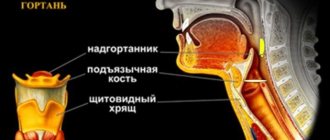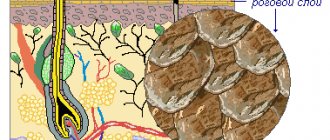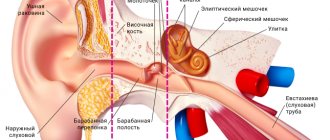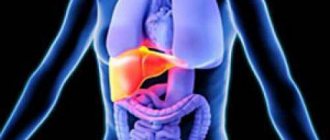(oropharynx) - part of the pharynx located between the soft palate and the hyoid bone (which is located next to the upper part of the epiglottis).
Share:
The pharynx is a cylindrical, slightly compressed in the sagittal direction, a funnel-shaped muscular tube 12 to 14 cm long, located in front of the cervical vertebrae. The vault of the pharynx (upper wall) connects to the base of the skull, the back part is attached to the occipital bone, the side parts to the temporal bones, and the lower part passes into the esophagus at the level of the sixth vertebra of the neck.
The pharynx is the crossroads of the respiratory and digestive tracts. During the swallowing process, food mass from the oral cavity enters the pharynx and then into the esophagus.
. Air from the nasal cavity through the choanae or from the oral cavity through the pharynx also enters the pharynx, and then into the larynx.
Anatomical structure of the throat and pharynx
The throat contains a large number of nerves, important blood vessels and muscles. There are two parts of the throat - the pharynx and larynx. Their trachea continues. The functions between the parts of the throat are divided as follows:
The pharynx moves food into the digestive system and air into the respiratory system. The vocal cords work thanks to the larynx.
Photo of vocal cords during laryngoscopy
Pharynx
Another name for the pharynx is pharynx. It starts at the back of the mouth and continues down the neck. The shape of the pharynx is an inverted cone.
The wider part is located at the base of the skull for strength. The narrow lower part connects to the larynx. The outer part of the pharynx continues with the outer part of the mouth - it has quite a lot of glands that produce mucus and help moisten the throat during speech or eating.
The pharynx has three parts - the nasopharynx, oropharynx and swallowing section.
Nasopharynx
The uppermost part of the pharynx. She has a soft palate, which limits her and, when swallowing, protects her nose from food getting into it. On the upper wall of the nasopharynx there are adenoids - a collection of tissue on the back wall of the organ. The nasopharynx is connected to the throat and middle ear by a special passage - the Eustachian tube. The nasopharynx is not as mobile as the oropharynx.
Oropharynx
Middle part of the pharynx. Located at the back of the oral cavity. The main thing this organ is responsible for is the delivery of air to the respiratory organs. Human speech is possible due to contractions of the muscles of the mouth. The tongue is also located in the oral cavity, which facilitates the movement of food into the digestive system. The most important organs of the oropharynx are the tonsils; they are the ones most often involved in various throat diseases.
Swallowing department
The lowest section of the pharynx with a self-explanatory name. It has a complex of nerve plexuses that help maintain synchronous functioning of the pharynx. Thanks to this, air enters the lungs, and food enters the esophagus, and everything happens at the same time.
Larynx
The larynx is located in the body as follows:
Opposite the cervical vertebrae (4-6 vertebrae). At the back is the immediate laryngeal part of the pharynx. In front - the larynx is formed thanks to a group of hyoid muscles. Above is the hyoid bone. Laterally, the larynx is adjacent with its lateral parts to the thyroid gland.
The larynx has a skeleton. The skeleton has unpaired and paired cartilages. Cartilage is connected by joints, ligaments and muscles.
Unpaired: cricoid, epiglottis, thyroid.
Paired: horn-shaped, aryten-shaped, wedge-shaped.
The muscles of the larynx, in turn, are also divided into three groups:
Four muscles narrow the glottis: the thyroarytenoid, cricoarytenoid, oblique arytenoid and transverse muscles. Only one muscle widens the glottis - the posterior cricoarytenoid. She is a steam room. Two muscles tense the vocal cords: the vocal cord and the cricothyroid.
The larynx has an entrance.
Behind this entrance are the arytenoid cartilages. They consist of horn-shaped tubercles that are located on the side of the mucous membrane. In front is the epiglottis. On the sides there are aryepiglottic folds. They consist of wedge-shaped tubercles.
The laryngeal cavity is divided into three parts:
The vestibule stretches from the vestibular folds to the epiglottis, the folds are formed by the mucous membrane, and between these folds there is the vestibular fissure. The interventricular section is the narrowest. Stretches from the lower vocal cords to the upper ligaments of the vestibule. Its narrowest part is called the glottis, and it is created by intercartilaginous and membranous tissues. Subvocal area. Based on the name, it is clear that it is located below the glottis. The trachea expands and begins.
The larynx has three membranes:
The mucous membrane, unlike the vocal cords (they are made of squamous non-keratinizing epithelium), consists of multinucleated prismatic epithelium. Fibrous-cartilaginous membrane - consists of elastic and hyaline cartilages, which are surrounded by fibrous connective tissue, and provides this entire structure with the framework of the larynx. Connective tissue is the connecting part of the larynx and other formations of the neck.
The larynx is responsible for three functions:
Protective - the mucous membrane has ciliated epithelium, and it contains many glands. And if the food gets past, then the nerve endings carry out a reflex - a cough, which removes the food back from the larynx into the mouth. Respiratory - related to the previous function. The glottis can contract and expand, thereby directing air flow. Voice-forming - speech, voice. The characteristics of the voice depend on the individual anatomical structure. and the condition of the vocal cords.
The picture shows the structure of the larynx
Functions of the pharynx
The pharynx takes part in several vital functions of the body at once: eating, breathing, voice formation, and defense mechanisms.
All parts of the pharynx are involved in the respiratory function, since air entering the human body from the nasal cavity passes through it.
The voice-forming function of the pharynx is to form and reproduce sounds produced in the larynx. This function depends on the functional and anatomical state of the neuromuscular apparatus of the pharynx. During the pronunciation of sounds, the soft palate and tongue, changing their position, close or open the nasopharynx, ensuring the formation of timbre and pitch of the voice.
Pathological changes in voice can occur due to impaired nasal breathing, congenital defects of the hard palate, paresis or paralysis of the soft palate. Nasal breathing disorders most often occur due to enlargement of the nasopharyngeal tonsil as a result of pathological proliferation of its lymphoid tissue
.
The growth of adenoids leads to an increase in pressure inside the ear, while the sensitivity of the eardrum is significantly reduced
. The circulation of mucus and air in the nasal cavity is inhibited, which promotes the proliferation of pathogens.
The esophageal function of the pharynx is to form the acts of sucking and swallowing. The protective function is performed by the lymphoid ring of the pharynx, which, together with the spleen, thymus and lymph nodes, forms a single immune system of the body
.
In addition, there are many cilia on the surface of the pharyngeal mucosa. When the mucous membrane is irritated, the muscles of the pharynx contract, its lumen narrows, mucus is released and a pharyngeal gag-cough reflex appears
. With a cough, all harmful substances adhering to the eyelashes are expelled.
Found an error in the text? Select it and press Ctrl + Enter.
Do you know that:
Human blood “runs” through the vessels under enormous pressure and, if their integrity is violated, it can shoot at a distance of up to 10 meters.
The cough medicine “Terpinkod” is one of the top sellers, not at all because of its medicinal properties.
More than $500 million a year is spent on allergy medications in the United States alone. Do you still believe that a way to finally defeat allergies will be found?
Over the course of a lifetime, the average person produces no less than two large pools of saliva.
Millions of bacteria are born, live and die in our intestines. They can only be seen under high magnification, but if they were put together, they would fit in a regular coffee cup.
Each person has not only unique fingerprints, but also tongue prints.
Besides people, only one living creature on planet Earth suffers from prostatitis - dogs. These are truly our most faithful friends.
It was previously believed that yawning enriches the body with oxygen. However, this opinion has been refuted. Scientists have proven that yawning cools the brain and improves its performance.
A job that a person doesn’t like is much more harmful to his psyche than no job at all.
In order to say even the shortest and simplest words, we use 72 muscles.
According to WHO research, talking on a mobile phone for half an hour every day increases the likelihood of developing a brain tumor by 40%.
In an effort to get the patient out, doctors often go too far. For example, a certain Charles Jensen in the period from 1954 to 1994
. survived more than 900 operations to remove tumors.
Research shows that women who drink several glasses of beer or wine per week have an increased risk of developing breast cancer.
American scientists conducted experiments on mice and came to the conclusion that watermelon juice prevents the development of vascular atherosclerosis. One group of mice drank plain water, and the second group drank watermelon juice. As a result, the vessels of the second group were free of cholesterol plaques.
Regular use of a solarium increases your chance of developing skin cancer by 60%.
Note to parents: what you need to know about influenza and ARVI
It is known that children get sick 5-10 times more often than adults. Therefore, experienced parents are familiar with the symptoms and even methods of treating most childhood ailments. But yes…
Morphological and syntactic properties
oropharynx
Noun, inanimate, feminine (type of declension ?? according to the classification of A. A. Zaliznyak).
Root: —
.
Pronunciation
Semantic properties
Meaning
- oral part of the pharynx?◆ The head intestine, or oropharynx
, in turn is divided into the oral cavity with walled salivary glands and the pharynx.
A.I. Akaevsky, “Anatomy of the reindeer”, 2013
Synonyms
- partially:
Antonyms
Hypernyms
Hyponyms
Related words
| Closest relationship | |
| |
Device principle
The throat is a highly complex organ responsible for breathing, speaking, and moving food.
In short, its structure is based, as we said earlier, on the pharynx (pharynx) and larynx (larynx). Since this organ is a conducting channel, it is very important that all its muscles work harmoniously and correctly. Inconsistency in their activities will lead to the fact that food can enter the respiratory system and create a dangerous situation, even leading to death.
The structure of a child's throat is the same as that of adults. But children have narrower cavities and tubes. As a result, any disease in which swelling of these tissues occurs can be extremely dangerous. It is advisable for a person to know the structure of such an organ, as this can be useful in caring for it and during treatment. In the pharynx, the nasopharynx and oropharynx are distinguished.
Doctor's actions during examination
How is the oropharynx examined? In order for the doctor not to block his view with his hand, he needs, simultaneously with the outer end of a special spatula, to move the back of the tongue to the left side, that is, to the left corner of the mouth. But this is not necessary if the doctor uses a knee-shaped, slightly curved spatula, because in this case the doctor’s hand will not interfere. If the oropharynx is examined correctly, using a non-curved medical spatula, then its outer end will be directed to the left and slightly raised up.
The oral part is examined to evaluate organs such as the palatine arches and tonsils, mucosa, dorsum of the tongue and posterior wall of the oropharynx. The normal size of the tonsils should not cover the posterior arches. If necessary, press on the upper part of the tonsils with a second medical spatula, which must be held in the right hand. It is with the help of a second medical spatula that pus can be squeezed out, which can accumulate in the scripts.
In order to examine the covered part of the tonsil, the doctor has to slightly pull back the last arch using a blunt hook, and the patient’s head must be turned slightly in the opposite direction. Sometimes, if certain conditions are met, the doctor examines the lower part of the oropharynx, the fourth tonsil and the surface of the tongue in the epiglottis.
Diseases, pathologies and injuries
The following problems exist:
Laryngospasm Insufficient hydration of the vocal cords Tonsillitis Sore throat Laryngitis Laryngeal edema Pharyngitis Laryngeal stenosis Paratonsillitis Pharyngomycosis Retropharyngeal abscess Scleroma Parapharyngeal abscess Damaged throat Hypertrophied palatine tonsils Hypertrophied adenoids Injuries of the mucous membranes Burns of the mucous membranes Throat cancer Bruise Cartilage fracture Trauma connections of the larynx and trachea Choking Laryngeal tuberculosis Diphtheria Acid intoxication Alkali intoxication Cellulitis
Related problems that cause sore throat:
Smoking Smoke inhalation Inhalation of dusty air Acute respiratory infection Whooping cough Scarlet fever Influenza
To determine the exact cause of your throat pain and irritation and to prescribe appropriate treatment, consult your doctor immediately.
Popular video on the structure and functions of the larynx:
The throat and larynx are important components of the body with a huge range of functions and a very complex structure. It is thanks to the throat and lungs that people breathe, the oral cavity is used for eating food, and also performs a communicative function. After all, we owe the ability to make articulate sounds to the mouth and tongue, and communication through speech is the main form of human communication.
The oropharynx is...
Another element in the structure of the human throat and larynx is the oropharynx.
This fragment is located behind the oral cavity. Its main function is to conduct air flow from the mouth to the respiratory organs. This part is more mobile compared to the nasopharynx. Thanks to this, when the muscle tissue of the oral cavity contracts, a person can speak.
We already know that the structure of the throat has certain components, but they will also include other, even smaller components. Among them is the tongue, which helps, by contracting the muscular systems, move food into the esophagus. There are also tonsils, which are very often involved in throat diseases.
Diagnostics
After an examination by an oncologist and a dentist, a number of examinations are prescribed:
- blood test for HPV. The study is carried out using PCR, sequencing or enzyme analysis. Confirmation of human papillomavirus changes tumor treatment tactics;
- endoscopic examination of the larynx and oropharynx using laryngoscopy and pharyngoscopy;
- cytological examination. During laryngoscopy, the doctor takes a scraping from the mucous membrane and sends it for analysis. The cellular composition of the tumor is determined;
- biopsy. The removed area is stained with eosin and hematoxylin, and then a reaction to the drug is observed;
- CT/MRI. Tomography clarifies the location and size of the tumor;
- PAT. Shows the spread of the tumor to surrounding organs, as well as metastasis to the chest organs.
How does the human throat work?
The anatomy of the throat is quite complex and interesting to study, not only for the purpose of general development. Knowledge about the structure of the throat helps to understand how to maintain its hygiene, why you need to take care of your throat, how to prevent the occurrence of diseases and effectively treat diseases if they occur.
The throat consists of the pharynx and larynx. The pharynx (pharynx) is responsible for moving air through the respiratory tract into the lungs and moving food from the mouth to the esophagus. The larynx (larynx) regulates the functioning of the vocal cords and ensures the production of speech and other sounds.
The throat is located in the area of the 4th and 6th cervical vertebrae and looks like a cone tapering towards the bottom. The throat begins from the hyoid bone and, going down, passes into the trachea. The upper part of this canal provides its strength, and the lower part connects to the larynx. The throat and pharynx merge in the oral cavity. Large vessels are located on the sides, and the pharynx is located at the back. The human throat contains the epiglottis, cartilage, and vocal cords.
The larynx is surrounded by nine hyaline cartilages, united by joints, that is, movable joints. The largest of the cartilages is the thyroid. It is formed from two parts, visually reminiscent of square plates. Their connection forms the Adam's apple, located on the front side of the larynx. The Adam's apple is the largest cartilage of the larynx. The quadrangular plates of cartilage in men are combined at almost an angle of 90 degrees, which is why the Adam's apple clearly protrudes on the neck. In women, the Adam's apple can be felt, but it is more difficult to distinguish it on the surface of the neck, since the plates are combined at an angle of more than 90 degrees. Two small cartilages extend from the outer side of each plate in both men and women. They contain an articular plate that connects to the cricoid cartilage.
The cricoid cartilage is shaped like a ring due to the arches on the sides and front. Its task is to provide a movable connection with the thyroid and arytenoid cartilage.
The arytenoid cartilage, which performs the speech function, consists of hyaline cartilage and elastic processes to which the vocal cords are attached. The epiglottic cartilage, located at the root of the tongue and visually similar to a leaf, also joins them.
The epiglottis, together with the epiglottic cartilage, performs a very important function - it separates the respiratory and digestive tracts. At the moment of direct swallowing of food, the “gate” to the larynx closes, so that food does not penetrate into the lungs and vocal cords.
The voice is also formed thanks to cartilage. Some of them provide tension to the throat ligaments, which affects the timbre of the voice. Others, arytenoid, pyramid-shaped, allow the movement of the vocal cords and regulate the size of the glottis. Its increase or decrease affects the volume of the voice. This system is limited to the vocal folds.
The difference in the structure of the throat of an adult and a child is insignificant and consists only in the fact that in infants all the cavities are smaller. Therefore, throat diseases in children, accompanied by severe swelling, threaten to block the access of air to the respiratory tract.
Women and children have shorter vocal cords than men. In infants, the larynx is wide but short, and is located three vertebrae higher. The timbre of the voice depends on the length of the larynx. During adolescence, the formation of the larynx is completed, and the voice of boys changes significantly.
The human pharynx consists of several parts. Let's look at each of them in more detail.
The nasopharynx is located behind the nasal cavity and is connected to it through openings - choanae. Below the nasopharynx passes into the middle pharynx, on the sides of which the auditory tubes are located. Its inner part consists of a mucous membrane completely covered with nerve endings, mucus-producing glands and capillaries. The main functions of the nasopharynx are to warm the air inhaled into the lungs, humidify it, and filter germs and dust. It is also thanks to the nasopharynx that we can recognize and smell odors.
Introduction to the larynx
The structure of the throat has another important component fragment - the larynx.
This organ occupies space at the level of the 4th, 5th and 6th cervical vertebrae. The hyoid bone is located above the larynx, and a group of hyoid muscles is formed in front. The lateral areas rest against the thyroid gland. The area located behind contains the laryngeal fragment of the pharynx.
Cartilage forms the skeleton of this area, connecting to each other through ligaments, muscle groups and joints. Among them, paired and unpaired are distinguished.
Paired cartilages:
- arytenoid pair;
- horn-shaped pair;
- wedge-shaped pair.
Unpaired cartilages:
- cricoid;
- supraglottic;
- thyroid.
In the muscular system of the larynx, there are three main groups of muscle formations. Among them there are tissues responsible for reducing the lumen of the glottis, tissues intended to expand the vocal cords, and tissues that strain the vocal cords.
Features of the voice apparatus
All cartilages of the larynx are connected to each other through many ligaments consisting of connective tissue. The true vocal cords protrude into the lumen of the larynx. The vocal (thyroarytenoid) muscle is located in the thickness of these ligaments. The vocal cords are stretched between the inner surface of the thyroid and the vocal process of the arytenoid cartilage.
During active inspiration, the vocal cords form a triangular glottis, sufficient for the normal passage of air. The vocal cords move, move closer together and form gaps of different shapes and sizes. This is how sounds are formed.
Above the true vocal cords are the false ones. They are folds of the mucous membrane. Together they form two slit-like spaces along the lateral surfaces, which are called Morganian ventricles. They contain a large number of mucous glands, thanks to which the vocal cords are moistened, facilitating the formation of sounds.
The throat takes part in ensuring the functioning of two important systems of the body, the activity of which is related to the external environment: respiratory and digestive. In addition, together with other anatomical structures (tongue, palate), the throat forms a person’s ability to make sounds.
The pharynx is a unique organ of the human body where the respiratory and digestive tracts intersect. It ensures the movement of the food bolus from the oral cavity into the esophagus and at the same time conducts air from the nasal passages or mouth to the larynx, that is, to the external respiratory organ.
Main functions of the larynx:
Thanks to the larynx, a person can hold his breath and prevent liquid from entering the respiratory tract. The structure of the throat and larynx make it possible to voluntarily and involuntarily block the flow of moving air, which protects the lung tissue.
The glottis is formed in the larynx, which provides sound production. Also, the presence of a large number of nerve endings provides reflexes aimed at removing foreign bodies and saliva that have entered the organ. Thanks to coughing and gagging movements, the airways are cleared of obstacles to the normal flow of air.
When a foreign body enters the glottis area, the muscle fibers contract and the lumen of the larynx sharply decreases. This, on the one hand, does not allow blocking the airways at a lower level. This complication can be dangerous due to the development of purulent inflammation and tissue damage. On the other hand, a sudden attack of suffocation may occur, which requires emergency assistance aimed at freeing the lumen of the larynx or ensuring air access.
The anatomical structures that form the human throat provide a number of important life-supporting functions. Interaction with the environment requires not only a contract and the normal movement of air and food along the appropriate paths, but also full protection from adverse factors. The voice apparatus enables communication with other people.
Ensuring hygiene of the oral cavity and throat, maintaining healthy tonsils, pharynx and larynx can prevent a significant number of diseases not only of the ENT organs, but also of the respiratory and digestive systems.
Author: Anna Sanno, doctor, especially for Moylor.ru
Chewing
text_fields
text_fields
arrow_upward
During chewing, food is ground in the oral cavity. Chewing involves the upper and lower jaws, teeth, tongue, cheeks, and masticatory muscles.
.
In this case, food is crushed, which greatly facilitates its subsequent digestion and absorption
.
Although chewing is a voluntary action, it is mainly carried out as an involuntary reflex act: when pieces of food come into contact with the palate and teeth, reflex chewing movements occur
.
In this case, food is moved using coordinated movements of the tongue and cheeks throughout the oral cavity. A full set of teeth is required to achieve maximum grinding of food
. During the chewing process, salivation is reflexively triggered. Food moistened with saliva is easily swallowed.
Functions of the throat and larynx
To summarize the above, the throat and larynx perform:
Protective function - the nasopharynx warms the air when inhaled, cleans it of germs and dust, and the tonsils produce immunoglobulin to protect against germs and viruses. Voice-forming function - cartilage controls the movement of the vocal cords, while changing the distance between the ligaments regulates the volume of the voice, and the force of their tension - timbre. The shorter the vocal cords, the higher the pitch of the voice. Respiratory function - air enters first the nasopharynx, then the pharynx, larynx and trachea. Villi on the surface of the pharyngeal epithelium prevent foreign bodies from entering the respiratory tract. And the structure of the nasopharynx itself helps to avoid asphyxia and laryngospasms.
Causes
The incidence of oropharyngeal cancer peaked in 2015-2016. The diagnosis was made in 13% of the total number of cancer patients, while the mortality rate reached 7.5%. The mortality of every second patient is due to the spread of cancer cells in the oral cavity and pharynx, and every third is due to the spread of cancer in the larynx. Today, the incidence has decreased and is 8.7%, but the mortality rate remains high.
The main cause of oropharyngeal cancer is smoking and drinking strong alcoholic beverages. Every third patient is an experienced smoker. Toxic substances first penetrate the pharynx, systematically irritating the mucous membrane and destroying bone structures.
The risk group includes:
- patients with HPV. The formation of papillomas on the mucous membrane of the mouth and pharynx can develop into oncology, especially with papilloma virus 16 strain;
- aged people;
- people who have been exposed to powerful ultraviolet radiation;
- weakened immunity. This group includes HIV-infected people, as well as people who have been treated with immunosuppressive drugs for a long time;
- patients with congenital dyscreratosis and Fanconi anemia.
Nasopharyngeal compound
The structure of the throat and larynx includes the structures that form them, such as the nasopharynx and oropharynx mentioned above. Let's consider one of them.
The nasopharynx is the part of the pharynx that occupies the upper position. It is limited from below by the soft palate, which begins to move upward during the process of swallowing. Thus, it covers the nasopharynx. This is necessary to protect it from food particles entering the respiratory tract. In the upper wall of the nasopharynx there are adenoids - tissue accumulations located behind its wall. This organ also has a tunnel connecting the throat to the middle ear. This formation is called the Eustachian tube.
Nasopharynx
text_fields
text_fields
arrow_upward
The nasopharynx is the uppermost, complex part of the pharynx. Through the choanae it communicates with the nasal cavity. The nasopharynx is separated from the oral cavity by the soft palate, which fits tightly to the root of the tongue when breathing, and when swallowing, on the contrary, separating it from the rest of the pharynx. On the lateral walls of the nasopharynx at the level of the choanae there are openings of the auditory (Eustachian) tubes
. By connecting the nasopharynx with the middle ear cavity, these tubes ensure equalization of air pressure in the middle ear with external pressure. Between the opening of the auditory tube and the soft palate lies the tubal tonsil, and on the arch of the nasopharynx lies the pharyngeal tonsil.
Prevention of throat diseases
During the cold season in countries with temperate climates, it is very easy to get a cold or sore throat. To avoid sore throat and viral diseases, you should:
Clear your throat with gargles. For rinsing, you need to use warm water, gradually reducing its temperature. Instead of water, you can use a decoction of medicinal plants - calendula or sage, pine cones, eucalyptus. Change your toothbrush once a month and after illness, to avoid becoming re-infected by germs remaining on the brush, visit the dentist. Constantly strengthen your immune system with a varied and nutritious diet, drink not too hot tea with lemon or fruit juice made from wild berries and fruits. For preventive purposes, you can use rosehip decoction and syrup, propolis, and garlic. If possible, limit contact with sick people and use gauze bandages. Avoid hypothermia and getting your feet wet in cold weather. Periodically ventilate the room and carry out wet cleaning. At the first symptoms of a throat disease, protect it from cold and take antiviral drugs. The ideal medicine for the throat is honey - a natural antiseptic. Honey should be consumed not only during illness, but also for prevention every day. Seek medical help promptly. Only after consulting a doctor and on his recommendation can you take antibiotics. If the course of the disease is favorable, it is better to complete any course of treatment to avoid complications.
Hemorrhage
The result of the work of the arterial structure of the body is the blood supply, which fills with blood and ensures the complete function of the organ of interest to us.
The responsible systemic part occurs when the procedure is initiated, not without the active activity of the vagus nerve, which comes to the rescue and performs motor functions.
Between the left and right hemispheres of the brain, behind the frontal gyrus, there is a center that is responsible for the process of coordinating the formation of voice. If disturbances in the functioning of the center occur due to early hearing loss, this is fraught with muteness and loss of the motor reflex.
Role of the trachea
The trachea has the form of a tube consisting of elastic cartilaginous half-rings. At the top, the trachea is a continuation of the larynx, and downwards it divides into 2 tubes and gives rise to the bronchi. The trachea of an adult at rest lies at the level of the fourth vertebrae of the thoracic spine. The length of this organ is 9-11 cm, the diameter of the lumen is 1.5-1.8 cm. The trachea is surrounded by connective tissue, which allows the larynx and trachea to move when performing active movements.
The upper part of the organ is located closer to the wall of the neck, while the lower segment of the trachea is closer to the back. The trachea, in addition to an abundant layer of connective tissue, is covered by cervical muscles and fascia. A pair of common carotid arteries runs on either side of the tube.
The trachea consists of 16-20 cartilaginous half-rings, which are connected to each other through fibrous ligaments. Each ring covers approximately 2/3 of the circumference of the tube. At the back, the organ has a muscular wall that allows the trachea to move during breathing, coughing, etc. Inside the tube is lined with ciliated epithelial cells, lymphoid tissue and mucus-secreting glands.
Muscular wall of the pharynx
text_fields
text_fields
arrow_upward
The muscular wall of the pharynx is built of striated muscles, which consists of three pairs of flat circular compressor muscles and two pairs of weak muscles with longitudinal fibers that lift the pharynx (see Atl.). Consecutive contraction of the constrictor muscles (as well as the muscles of the soft palate and tongue) during the passage of a bolus of food causes the act of swallowing
. The pharyngeal muscles are innervated by the vagus and glossopharyngeal nerves.
Muscles
Next we will see the important functions of elastic fabrics:
- Tensioning. Located at the front arch. They begin and attach to the lower side of the wall, their purpose is to excite the upper nerve.
- Vocal - originates at the thyroid attachment, to be more precise, near the cut, and is perfectly attached to the process, which is the vocal.
- Muscles responsible for expansion, as well as quality of speech. Active communication directly depends on them. Lateral displacement of the process occurs when the elastic tissue is pulled.
- Constricting - due to tension, the process moves medially.
- The oblique muscle has the ability to move the pharynx backward, thus blocking the path to the middle of the organ.
The throat can be compared to a musical instrument that is safely built into the human body. At the level of the cervical vertebral ribs of the fifth and fourth numbers, a change in the tension of the level of elastic and soft coverings occurs. This structure of the throat makes it possible to play with sounds and shades of voice. Pronounce lower, higher, stronger.
Having studied the structure of the throat, we can come to the conclusion that this part of the body is mobile, has numerous nerve fibers and is very sensitive to various mechanical stimuli - both internal and external. Therefore, you need to protect your throat. Be healthy!










